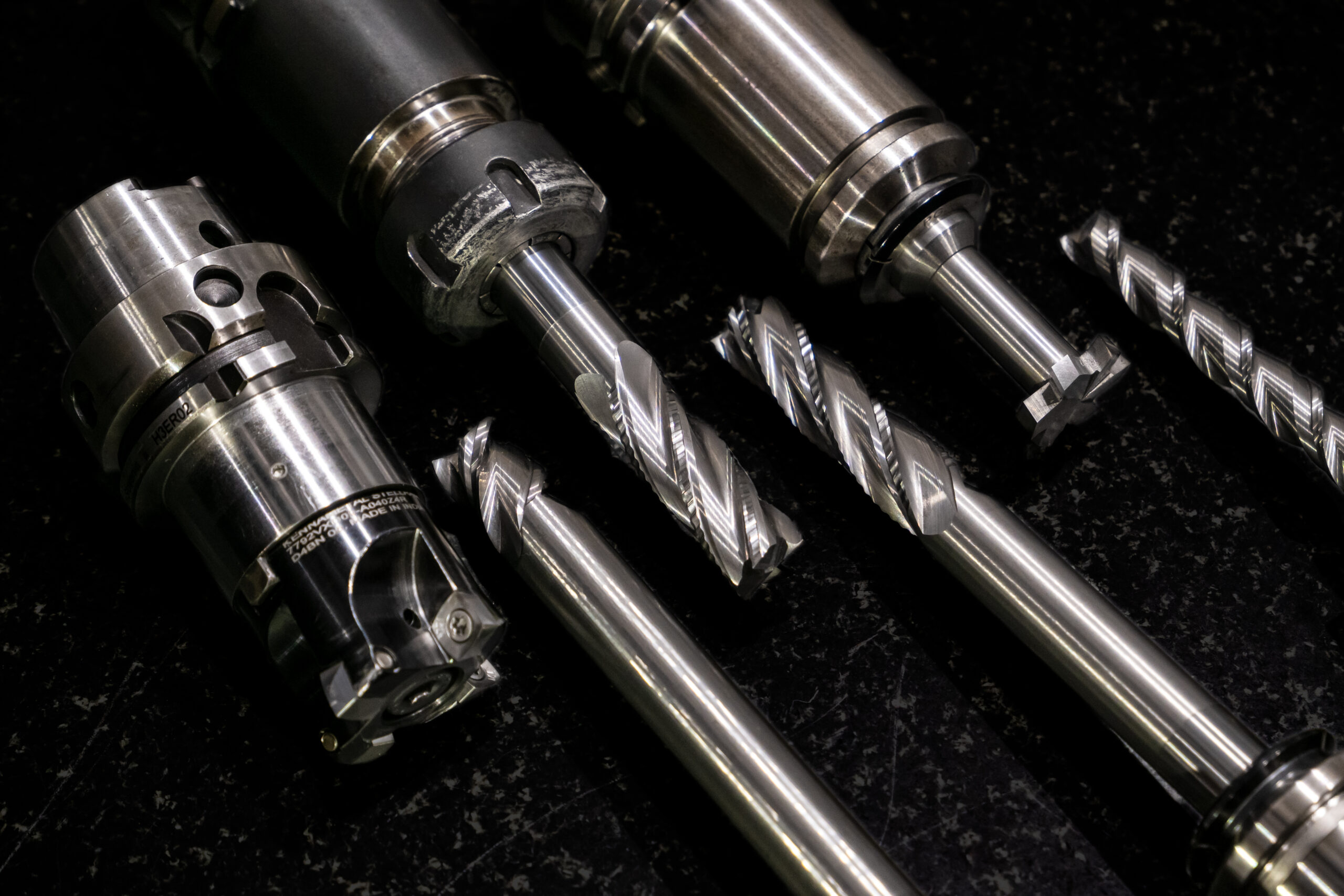Advancement of Aerospace Industry with CNC Machining
The aerospace industry is currently undergoing a significant transformation, characterized by an increasing demand for high-performance yet lightweight components. This shift, crucial in an industry where weight impacts fuel efficiency and payload, is driven by two main factors:
- High-Performance and Lightweight Components: There’s a growing need for components that enhance efficiency and resilience without adding extra weight. This trend is reshaping how engineers and designers approach aerospace projects, prioritizing weight without compromising on performance.
- Advanced Materials and Complex Geometries: The introduction of materials like carbon fiber composites and titanium alloys, alongside complex designs, is expanding the possibilities in aerospace engineering. These advancements present challenges and opportunities, pushing past the limits of traditional manufacturing methods.

In this evolving landscape, high-precision CNC machining has become essential. Known for its unparalleled precision, CNC machining is crucial in an industry where even the slightest error can have significant consequences. This technique is defined by its ability to adhere to extremely tight tolerances, measured in thousandths of an inch, a standard well-understood by Ethereal Machines with its ISO 9001:2015 and AS9100D certifications. High-precision CNC stands out in aerospace for its unique ability to handle complex parts made from exotic materials and ensure the integrity.
Critical Considerations for High-Precision CNC in Aerospace

1) Material Selection and Pre-Processing
a) Understanding Material Properties and Behavior
- Stainless Steel: Offers excellent strength and corrosion resistance, making it ideal for components like landing gear and fasteners. However, its machinability is moderate due to its hardness.
- Nickel Alloys: Known for their exceptional high-temperature strength and corrosion resistance, they are used in critical high-heat components like turbine blades. Machining nickel alloys is challenging due to their hardness and work-hardening properties.
- Magnesium Alloys: These are the lightest structural metals, used for their weight advantage in components like gearboxes. However, their susceptibility to corrosion requires careful handling and coating processes.
- Ceramics: Ceramics are used for their heat resistance and insulating properties in components like thermal insulation and sensors. Their brittleness makes machining challenging, often requiring specialized equipment.
b) Selecting Appropriate Cutting Tools and Strategies
- Material Compatibility: The choice of cutting tools is heavily influenced by the material properties. For instance, materials like titanium require tools that can withstand high stress and temperature without degrading.
- Tool Geometry and Coating: The geometry of the tool, including angles and flute design, should be matched to the material’s characteristics. Special coatings like titanium aluminum nitride (TiAlN) can enhance tool life and performance, especially in high-temperature environments.
- Customization for Specific Materials: Tools often need customization for specific aerospace materials. For example, machining nickel alloys may require tools with a high positive rake angle to reduce cutting forces and prevent work hardening.
- Speed and Feed Rate: These parameters must be optimized to balance machining efficiency with the quality of the machined surface. A higher feed rate might increase production speed but could compromise surface finish and tool life.
- Cooling Techniques: Effective cooling is crucial, especially when machining materials like titanium that generate significant heat. Coolant type and delivery method must be carefully selected to prevent thermal damage to both the tool and the material.
- Roughing vs. Finishing: Roughing strategies may prioritize speed and material removal rate while finishing focuses on achieving high precision and surface quality.
- Adaptive Machining: Advanced CNC machines can adapt their machining strategy in real-time based on feedback from sensors, optimizing tool paths for efficiency and precision.
- Vibration Management: Minimising vibrations through tool choice and machining parameters is critical, especially in finishing operations, to ensure the highest quality of the machined part.
c) Optimized Pre-Processing Techniques for Surface Quality and Dimensional Accuracy
Material Alignment and Stabilization:
- Importance: Proper alignment and stabilization of materials are crucial to avoid any deviations during the machining process.
- Techniques: Use of precision jigs and fixtures, vibration dampening methods, and ensuring material homogeneity.
- Outcome: Minimized material movement or deformation during machining, leading to higher accuracy.
Control of Machining Parameters:
- Parameters to Control: Cutting speed, feed rate, depth of cut, and tool path.
- Precision Engineering: Application of predictive models and real-time monitoring systems to fine-tune these parameters.
- Result: Enhanced surface finish and adherence to tight dimensional tolerances.
Advanced Milling and Turning Techniques:
- Technological Advances: Use of multi-axis CNC machines, high-speed machining, and ultra-precision cutting tools.
- Strategic Application: Implementing techniques like climb milling for better surface finish and reduced tool wear.
- Impact: Improved accuracy in complex geometries and superior surface quality.

2) Quality Control and Inspection
a) Multi-layered Quality Control System
Layered Approach to Quality Assurance
- In aerospace CNC machining, the quality control system is structured in layers, each focusing on a specific aspect of the production process. This layered approach ensures that quality is not just a final inspection checkpoint but an integral part of the entire manufacturing process.
Initial Material Inspection
- The first layer often involves the inspection of raw materials. This includes verifying material certifications, conducting tests to confirm material properties, and ensuring that the materials are free from defects or inconsistencies that could affect the final product.
In-process Quality Checks
- As the machining process begins, in-process quality checks are conducted. These include monitoring the machining parameters like cutting speed, feed rate, and tool condition. This layer ensures that the machining process adheres to the predefined standards and that any deviations are corrected in real-time.
Post-machining Inspections
- After machining, each part undergoes detailed inspections. This involves dimensional and geometric checks using precision measuring instruments. Advanced techniques like 3D scanning may be used for complex geometries, ensuring that every aspect of the part conforms to the exact specifications.
Final Quality Assurance
- The final layer of quality control involves a comprehensive review of the finished product. This might include functional testing, surface finish examination, and a final check against the design specifications. It ensures that the part is ready for use in aerospace applications and meets all required standards.
b) Material Quality Assessments
The components produced are often destined for critical aerospace applications, where a minor flaw can have catastrophic consequences. This underscores the need for an exhaustive and infallible QC process. Know more about “Material Quality Assessments for aerospace component“.
c) 3D Coordinate Measuring Machines (CMM)
- These devices offer unparalleled precision in measuring complex geometries. They are crucial for validating the dimensional accuracy of machined components.
- CMMs can inspect to micron-level precision, crucial for components that must function reliably in the extreme conditions of aerospace environments. Know more about “Exploring the World of CMM in CNC Machining“.
d) Statistical Process Control (SPC) in Aerospace CNC Machining
1. The Role of SPC in Quality Management
- SPC is a method of quality control that uses statistical methods to monitor and control a manufacturing process. This approach helps detect and address variances in the CNC machining process that could lead to defects.
- In aerospace CNC machining, SPC involves collecting data from various stages of the machining process. This data includes measurements of dimensions, surface finish, and other critical parameters that define the quality of the component.
2. Real-Time Monitoring and Adjustments
- One of the key benefits of SPC is its ability to provide real-time feedback. CNC machines equipped with SPC capabilities can automatically adjust machining parameters in response to detected variances.
- This proactive approach minimizes the occurrence of defects by correcting deviations as they happen, rather than after the fact.
3. Identifying Trends and Root Causes
- SPC tools analyze data over time, allowing engineers to identify trends that might indicate underlying issues in the machining process.
- This analysis can lead to the discovery of root causes of defects, such as tool wear, machine misalignment, or material inconsistencies, enabling targeted corrective actions.
e) Continuous Improvement in Aerospace CNC Machining
1.Data-Driven Improvement Cycle
- Continuous improvement in aerospace CNC machining is driven by the data collected through SPC and other quality control measures.
- This data is analyzed to identify areas for improvement, whether in the machining process, tooling, or material handling. The insights gained are then used to make informed changes to enhance quality and efficiency.
2. Enhancing Efficiency and Reducing Waste
- By continuously refining the machining process, aerospace CNC operations become more efficient, reducing cycle times and increasing throughput.
- This efficiency also leads to reduced material waste, as precision in machining means fewer errors and rejections. The result is a more cost-effective manufacturing process that also aligns with sustainability goals.
3. Advancement of Aerospace Component Manufacturing
- Continuous improvement, fueled by SPC, plays a vital role in advancing aerospace component manufacturing.
- The adoption of new technologies, materials, and machining strategies, informed by ongoing data analysis, ensures that aerospace CNC machining remains at the cutting edge. This leads to the production of more advanced, reliable, and high-performance aerospace components.
Future Trends and Emerging Technologies:
1) Integration of AI and Machine Learning for Intelligent Toolpath Optimization
2) Automation and Robotics for High-Precision CNC Operations
3) The Future of High-Precision CNC in Aerospace, Opportunities and Challenges
4) Impact of 5G and IoT on CNC Machining Efficiency:
Conclusion
In the dynamic world of aerospace engineering, high-precision CNC machining stands as a pillar of innovation and precision. This field, essential for aerospace excellence, encompasses meticulous material processing, advanced tooling, and rigorous quality control. CNC technology is crucial in manufacturing aircraft and spacecraft components, ensuring top-tier performance and reliability. It’s pivotal in advancing aerospace research and pushing materials and manufacturing limits. The future beckons with AI, machine learning, automation, 5G, and IoT, heralding new efficiency and innovation levels. This domain epitomizes human ingenuity’s pursuit of perfection, with CNC technology playing a critical role in the evolving aerospace narrative.
<span data-metadata=""><span data-metadata=""><span data-buffer="">MAAS
Machining As A Service
On-demand CNC Machining Services by Ethereal Machines offers the perfect solution for your CNC machining needs. With secure and confidential processes, you can get an instant quote and access expert advice from their technical team. Whether you need custom CNC machined parts or have a specific project in mind, Ethereal Machines is committed to helping you every step of the way. Try MAAS now and achieve your goals with ease.
Views: 1284









